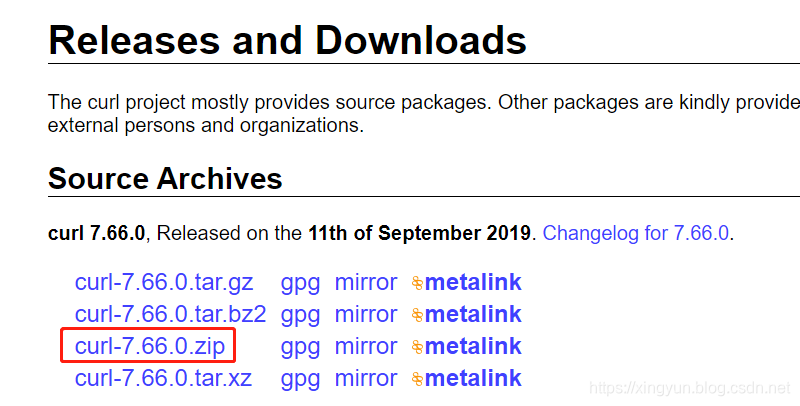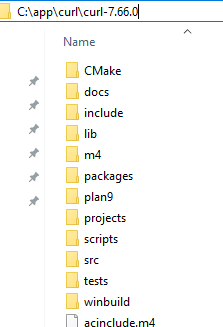Curl 下载安装和配置
1.1 什么是Curl?
Curl 是一个命令行工具和库,用于通过URL传输数据。
简单来说呢,根据我的理解
Curl 就是一个可以通过命令行发送GET,POST 等多种协议请求的工具。
1.2 Curl 支持的网络协议
DICT, FILE, FTP, FTPS, Gopher, HTTP, HTTPS, IMAP, IMAPS, LDAP, LDAPS,
POP3, POP3S, RTMP, RTSP, SCP, SFTP, SMB, SMBS, SMTP, SMTPS, Telnet and
TFTP. curl supports SSL certificates, HTTP POST, HTTP PUT, FTP
uploading, HTTP form based upload, proxies, HTTP/2, cookies,
user+password authentication (Basic, Plain, Digest, CRAM-MD5, NTLM,
Negotiate and Kerberos), file transfer resume, proxy tunneling and
more.
1.3 Curl 是做什么用的?
- Curl在命令行或脚本中用于传输数据。
- 它还用于汽车,电视机,路由器,打印机,音频设备,手机,平板电脑,机顶盒,媒体播放器中,并且是数千种每天影响数十亿人口的软件应用程序的互联网传输基础。
- Curl 是免费开源的
1.4 Curl 如何下载安装?
1.4.1 Windows 平台
2019年9月11日 当前最新版本是7.66.0
打开上面网址后,我们可以看到这样的界面

- 如果是windows 操作系统就点击图中所示这个。
- 如果是linux 请下载对应的版本。
1.4.2 Linux 平台
Linux 平台的下载和安装方法见这里 Get curl for Linux
1.4.3 Mac OS 平台
如果你使用的Mac OS 操作系统,那么可以参考Get curl for macOS
1.5 Curl 配置
1.5.1 解压
下载完成后,我解压到了这样一个目录
C:\app\curl\curl-7.66.0

1.5.2 配置环境变量
Curl 和其他一些常用的Java 工具一样,如果我们想要在命令行的任意路径下使用它,最好把它添加到Path环境变量里。
我们新建一个环境变量
CURL_HOME
C:\app\curl\curl-7.66.0
效果如图所示

然后Path中追加这个环境变量即可
%CURL_HOME%\bin\
效果图如下所示

1.5.3 验证安装配置是否成功
如果想验证是否安装配置成功,可以输入如下命令即可
curl --version
或者
curl -v / --version
值得注意的是,貌似它针对windows 平台的Powshell 支持不够友好,输入这个名会报错,只能在cmd下才可以。
1.6 如何使用Curl?
命令行下输入命令
curl --help
输出命令语法如下:
Usage: curl [options...] <url>
--abstract-unix-socket <path> Connect via abstract Unix domain socket
--anyauth Pick any authentication method
-a, --append Append to target file when uploading
--basic Use HTTP Basic Authentication
--cacert <CA certificate> CA certificate to verify peer against
--capath <dir> CA directory to verify peer against
-E, --cert <certificate[:password]> Client certificate file and password
--cert-status Verify the status of the server certificate
--cert-type <type> Certificate file type (DER/PEM/ENG)
--ciphers <list of ciphers> SSL ciphers to use
--compressed Request compressed response
-K, --config <file> Read config from a file
--connect-timeout <seconds> Maximum time allowed for connection
--connect-to <HOST1:PORT1:HOST2:PORT2> Connect to host
-C, --continue-at <offset> Resumed transfer offset
-b, --cookie <data> Send cookies from string/file
-c, --cookie-jar <filename> Write cookies to <filename> after operation
--create-dirs Create necessary local directory hierarchy
--crlf Convert LF to CRLF in upload
--crlfile <file> Get a CRL list in PEM format from the given file
-d, --data <data> HTTP POST data
--data-ascii <data> HTTP POST ASCII data
--data-binary <data> HTTP POST binary data
--data-raw <data> HTTP POST data, '@' allowed
--data-urlencode <data> HTTP POST data url encoded
--delegation <LEVEL> GSS-API delegation permission
--digest Use HTTP Digest Authentication
-q, --disable Disable .curlrc
--disable-eprt Inhibit using EPRT or LPRT
--disable-epsv Inhibit using EPSV
--dns-interface <interface> Interface to use for DNS requests
--dns-ipv4-addr <address> IPv4 address to use for DNS requests
--dns-ipv6-addr <address> IPv6 address to use for DNS requests
--dns-servers <addresses> DNS server addrs to use
-D, --dump-header <filename> Write the received headers to <filename>
--egd-file <file> EGD socket path for random data
--engine <name> Crypto engine to use
--expect100-timeout <seconds> How long to wait for 100-continue
-f, --fail Fail silently (no output at all) on HTTP errors
--fail-early Fail on first transfer error, do not continue
--false-start Enable TLS False Start
-F, --form <name=content> Specify HTTP multipart POST data
--form-string <name=string> Specify HTTP multipart POST data
--ftp-account <data> Account data string
--ftp-alternative-to-user <command> String to replace USER [name]
--ftp-create-dirs Create the remote dirs if not present
--ftp-method <method> Control CWD usage
--ftp-pasv Use PASV/EPSV instead of PORT
-P, --ftp-port <address> Use PORT instead of PASV
--ftp-pret Send PRET before PASV
--ftp-skip-pasv-ip Skip the IP address for PASV
--ftp-ssl-ccc Send CCC after authenticating
--ftp-ssl-ccc-mode <active/passive> Set CCC mode
--ftp-ssl-control Require SSL/TLS for FTP login, clear for transfer
-G, --get Put the post data in the URL and use GET
-g, --globoff Disable URL sequences and ranges using {} and []
-I, --head Show document info only
-H, --header <header/@file> Pass custom header(s) to server
-h, --help This help text
--hostpubmd5 <md5> Acceptable MD5 hash of the host public key
-0, --http1.0 Use HTTP 1.0
--http1.1 Use HTTP 1.1
--http2 Use HTTP 2
--http2-prior-knowledge Use HTTP 2 without HTTP/1.1 Upgrade
--ignore-content-length Ignore the size of the remote resource
-i, --include Include protocol response headers in the output
-k, --insecure Allow insecure server connections when using SSL
--interface <name> Use network INTERFACE (or address)
-4, --ipv4 Resolve names to IPv4 addresses
-6, --ipv6 Resolve names to IPv6 addresses
-j, --junk-session-cookies Ignore session cookies read from file
--keepalive-time <seconds> Interval time for keepalive probes
--key <key> Private key file name
--key-type <type> Private key file type (DER/PEM/ENG)
--krb <level> Enable Kerberos with security <level>
--libcurl <file> Dump libcurl equivalent code of this command line
--limit-rate <speed> Limit transfer speed to RATE
-l, --list-only List only mode
--local-port <num/range> Force use of RANGE for local port numbers
-L, --location Follow redirects
--location-trusted Like --location, and send auth to other hosts
--login-options <options> Server login options
--mail-auth <address> Originator address of the original email
--mail-from <address> Mail from this address
--mail-rcpt <address> Mail from this address
-M, --manual Display the full manual
--max-filesize <bytes> Maximum file size to download
--max-redirs <num> Maximum number of redirects allowed
-m, --max-time <time> Maximum time allowed for the transfer
--metalink Process given URLs as metalink XML file
--negotiate Use HTTP Negotiate (SPNEGO) authentication
-n, --netrc Must read .netrc for user name and password
--netrc-file <filename> Specify FILE for netrc
--netrc-optional Use either .netrc or URL
-:, --next Make next URL use its separate set of options
--no-alpn Disable the ALPN TLS extension
-N, --no-buffer Disable buffering of the output stream
--no-keepalive Disable TCP keepalive on the connection
--no-npn Disable the NPN TLS extension
--no-sessionid Disable SSL session-ID reusing
--noproxy <no-proxy-list> List of hosts which do not use proxy
--ntlm Use HTTP NTLM authentication
--ntlm-wb Use HTTP NTLM authentication with winbind
--oauth2-bearer <token> OAuth 2 Bearer Token
-o, --output <file> Write to file instead of stdout
--pass <phrase> Pass phrase for the private key
--path-as-is Do not squash .. sequences in URL path
--pinnedpubkey <hashes> FILE/HASHES Public key to verify peer against
--post301 Do not switch to GET after following a 301
--post302 Do not switch to GET after following a 302
--post303 Do not switch to GET after following a 303
--preproxy [protocol://]host[:port] Use this proxy first
-#, --progress-bar Display transfer progress as a bar
--proto <protocols> Enable/disable PROTOCOLS
--proto-default <protocol> Use PROTOCOL for any URL missing a scheme
--proto-redir <protocols> Enable/disable PROTOCOLS on redirect
-x, --proxy [protocol://]host[:port] Use this proxy
--proxy-anyauth Pick any proxy authentication method
--proxy-basic Use Basic authentication on the proxy
--proxy-cacert <file> CA certificate to verify peer against for proxy
--proxy-capath <dir> CA directory to verify peer against for proxy
--proxy-cert <cert[:passwd]> Set client certificate for proxy
--proxy-cert-type <type> Client certificate type for HTTS proxy
--proxy-ciphers <list> SSL ciphers to use for proxy
--proxy-crlfile <file> Set a CRL list for proxy
--proxy-digest Use Digest authentication on the proxy
--proxy-header <header/@file> Pass custom header(s) to proxy
--proxy-insecure Do HTTPS proxy connections without verifying the proxy
--proxy-key <key> Private key for HTTPS proxy
--proxy-key-type <type> Private key file type for proxy
--proxy-negotiate Use HTTP Negotiate (SPNEGO) authentication on the proxy
--proxy-ntlm Use NTLM authentication on the proxy
--proxy-pass <phrase> Pass phrase for the private key for HTTPS proxy
--proxy-service-name <name> SPNEGO proxy service name
--proxy-ssl-allow-beast Allow security flaw for interop for HTTPS proxy
--proxy-tlsauthtype <type> TLS authentication type for HTTPS proxy
--proxy-tlspassword <string> TLS password for HTTPS proxy
--proxy-tlsuser <name> TLS username for HTTPS proxy
--proxy-tlsv1 Use TLSv1 for HTTPS proxy
-U, --proxy-user <user:password> Proxy user and password
--proxy1.0 <host[:port]> Use HTTP/1.0 proxy on given port
-p, --proxytunnel Operate through a HTTP proxy tunnel (using CONNECT)
--pubkey <key> SSH Public key file name
-Q, --quote Send command(s) to server before transfer
--random-file <file> File for reading random data from
-r, --range <range> Retrieve only the bytes within RANGE
--raw Do HTTP "raw"; no transfer decoding
-e, --referer <URL> Referrer URL
-J, --remote-header-name Use the header-provided filename
-O, --remote-name Write output to a file named as the remote file
--remote-name-all Use the remote file name for all URLs
-R, --remote-time Set the remote file's time on the local output
-X, --request <command> Specify request command to use
--request-target Specify the target for this request
--resolve <host:port:address> Resolve the host+port to this address
--retry <num> Retry request if transient problems occur
--retry-connrefused Retry on connection refused (use with --retry)
--retry-delay <seconds> Wait time between retries
--retry-max-time <seconds> Retry only within this period
--sasl-ir Enable initial response in SASL authentication
--service-name <name> SPNEGO service name
-S, --show-error Show error even when -s is used
-s, --silent Silent mode
--socks4 <host[:port]> SOCKS4 proxy on given host + port
--socks4a <host[:port]> SOCKS4a proxy on given host + port
--socks5 <host[:port]> SOCKS5 proxy on given host + port
--socks5-basic Enable username/password auth for SOCKS5 proxies
--socks5-gssapi Enable GSS-API auth for SOCKS5 proxies
--socks5-gssapi-nec Compatibility with NEC SOCKS5 server
--socks5-gssapi-service <name> SOCKS5 proxy service name for GSS-API
--socks5-hostname <host[:port]> SOCKS5 proxy, pass host name to proxy
-Y, --speed-limit <speed> Stop transfers slower than this
-y, --speed-time <seconds> Trigger 'speed-limit' abort after this time
--ssl Try SSL/TLS
--ssl-allow-beast Allow security flaw to improve interop
--ssl-no-revoke Disable cert revocation checks (WinSSL)
--ssl-reqd Require SSL/TLS
-2, --sslv2 Use SSLv2
-3, --sslv3 Use SSLv3
--stderr Where to redirect stderr
--suppress-connect-headers Suppress proxy CONNECT response headers
--tcp-fastopen Use TCP Fast Open
--tcp-nodelay Use the TCP_NODELAY option
-t, --telnet-option <opt=val> Set telnet option
--tftp-blksize <value> Set TFTP BLKSIZE option
--tftp-no-options Do not send any TFTP options
-z, --time-cond <time> Transfer based on a time condition
--tls-max <VERSION> Use TLSv1.0 or greater
--tlsauthtype <type> TLS authentication type
--tlspassword TLS password
--tlsuser <name> TLS user name
-1, --tlsv1 Use TLSv1.0 or greater
--tlsv1.0 Use TLSv1.0
--tlsv1.1 Use TLSv1.1
--tlsv1.2 Use TLSv1.2
--tlsv1.3 Use TLSv1.3
--tr-encoding Request compressed transfer encoding
--trace <file> Write a debug trace to FILE
--trace-ascii <file> Like --trace, but without hex output
--trace-time Add time stamps to trace/verbose output
--unix-socket <path> Connect through this Unix domain socket
-T, --upload-file <file> Transfer local FILE to destination
--url <url> URL to work with
-B, --use-ascii Use ASCII/text transfer
-u, --user <user:password> Server user and password
-A, --user-agent <name> Send User-Agent <name> to server
-v, --verbose Make the operation more talkative
-V, --version Show version number and quit
-w, --write-out <format> Use output FORMAT after completion
--xattr Store metadata in extended file attributes
关于Curl 如何使用HTTP ,官方有个文档
在HTTP 请求中,最常用的是下面几个方法:
- GET
- POST
- HEAD
- PUT
其中,Curl 方法执行约定如下
- 默认使用的是GET方法。
-d或者-F 指定为POST 方法-I指定为HEAD方法-T指定为PUT 方法
示例
1.6.1 发送一个GET 请求
curl http://example.com/file
执行完成后我们可以看到请求后返回来相应的页面源码

1.6.2 发送一个POST 请求
示例一:
curl -d 'name=admin&shoesize=12' http://example.com/
示例二:
curl -d name=admin -d shoesize=12 http://example.com/
示例三:
curl -d @filename http://example.com
1.6.3 发送一个DELETE
刚才默认的请求是GET 请求,我们也可以通过-X 参数指定请求的方法为DELETE
curl http://example.com/file -X DELETE
1.6.4 自定义请求头
如果自定义请求头,可以这么做
curl -H "Elevator: floor-9" http://example.com/
输出内容如下:

要修改User-Agent,那么输入如下命令:
curl -H "User-Agent:" http://example.com/
输出内容如下:

1.6.5 发送一个PUT 请求
发送一个PUT 请求使用-T 参数,命令如下:
curl -T localfile http://example.com/new/resource/file
因此-T表示PUT并告诉curl发送哪个文件,locafile 必须指定一个本地文件路径
但是POST和PUT之间的相似之处还允许您通过使用-d的常规curl POST机制来发送带有字符串的PUT,但要求它改为使用PUT:
curl -d "data to PUT" -X PUT http://example.com/new/resource/file
1.7 附录
关于参数列表如下:
| Verbose | Hide progress | extra info | Write output | Timeout |
| -v | -s | -w “format” | -O | -m |
| –trace-ascii | -o | |||
| POST | multipart | PUT | HEAD | custom |
| -d “string” | -F name=value | -T | -I | -X “METHOD” |
| -d @file | -F name=@file | |||
| Basic auth | read cookies | write cookies | send cookies | user-agent |
| -u user:password | -b | -c | -b “c=1; d=2” | -A “string” |
| Use proxy | Headers, add/remove | follow redirs | gzip | insecure |
| -x | -H “name: value” | -L | –compressed | -k |
| -H “name:” |